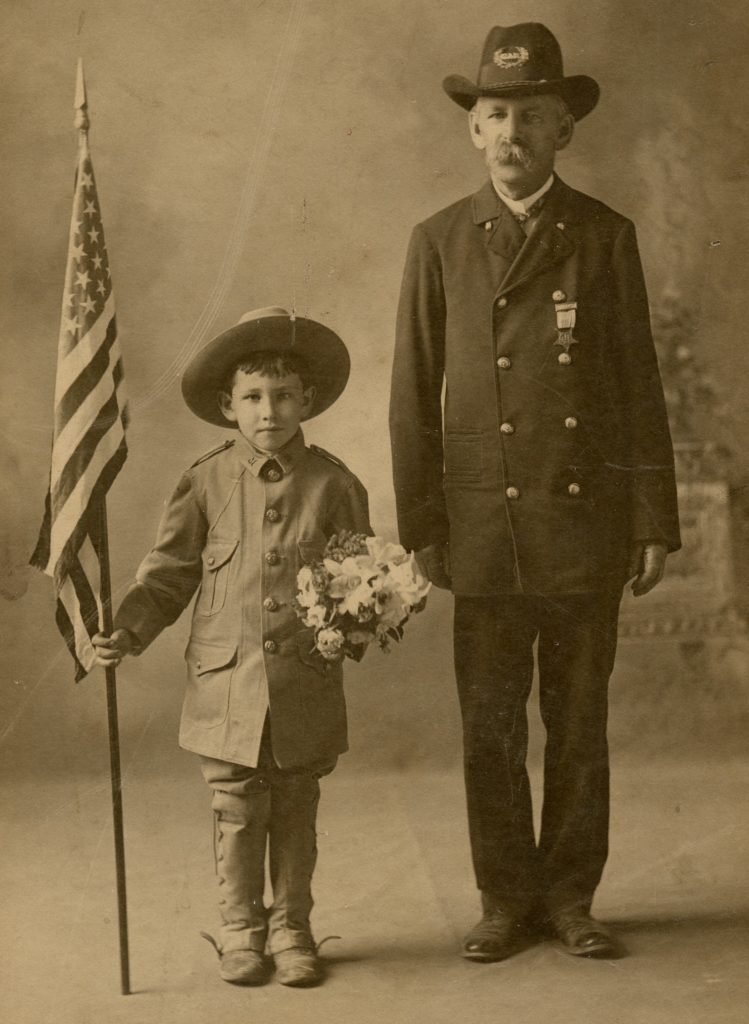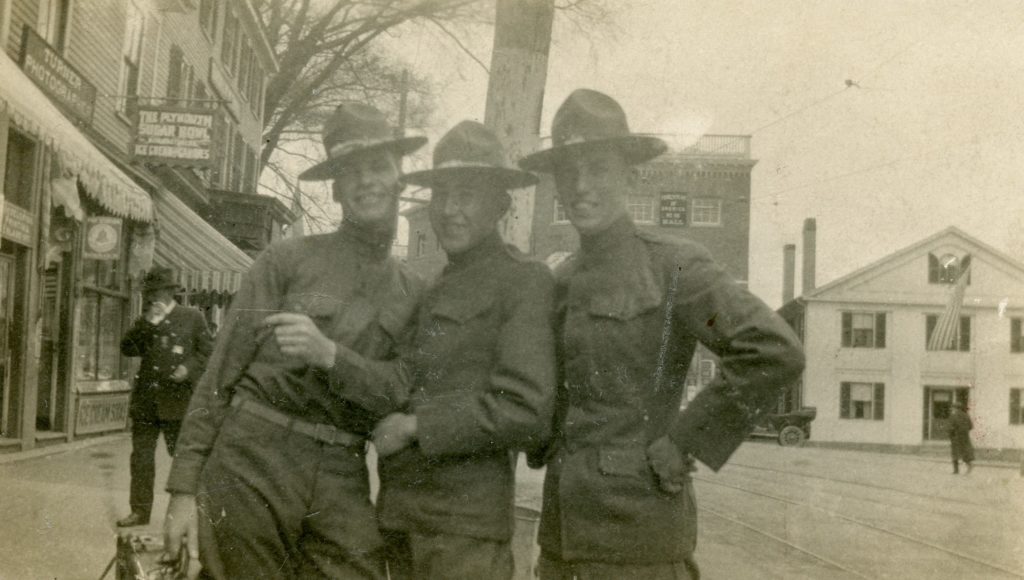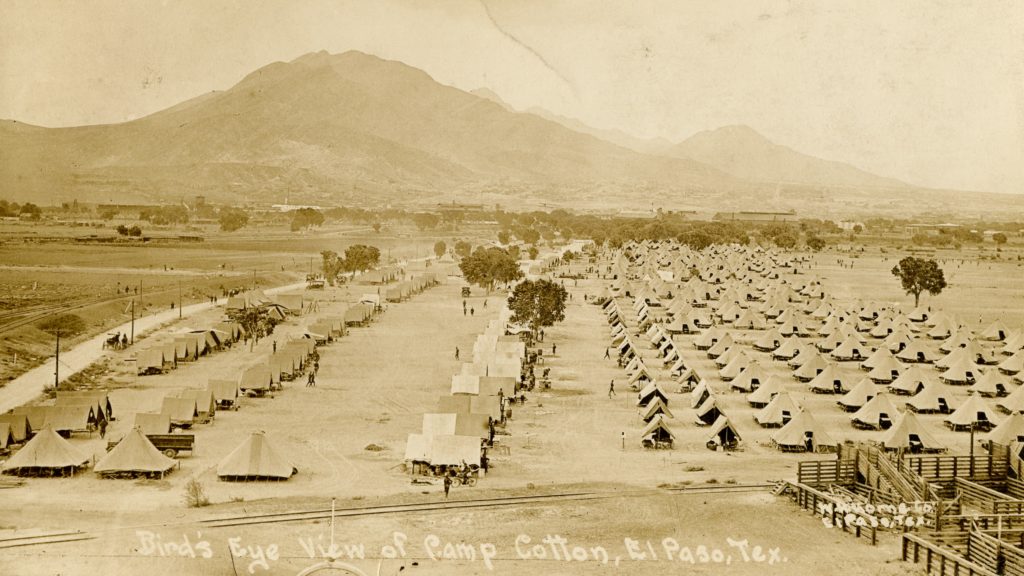This article originally appeared in the Antiquarian Society’s newsletter, Archives & Anecdotes, in June 2018.
One hundred years ago, as World War I came to an end in Europe, a deadly flu virus swept across the globe, killing millions. Although the influenza pandemic of 1918 came to be known as the Spanish flu, the first recorded cases were in the United States. The international movement of armies and refugees allowed the flu to spread rapidly across borders. It killed swiftly and, unlike other flu strains, attacked healthy young adults as well as children and the elderly.
On September 23, 1918, the flu claimed its first victim in Plymouth: 20-year-old Geoffrey D. Perrier, Jr. Born on June 18, 1898, Geoffrey was the eldest child and only son of Geoffrey Daniel Perrier, a French-speaking immigrant from Nova Scotia, and Mary Agnes O’Brien, whose family had immigrated to the United States from Ireland.
Two years before his death, Geoffrey Perrier, Jr. traveled across the country to serve in the often-forgotten Border War. This military engagement took place during the Mexican Revolution, which began in 1910. It reached its height in 1916 when the paramilitary forces of Mexican revolutionary Francisco “Pancho” Villa led an attack on Columbus, New Mexico. President Woodrow Wilson sent an expedition under General John Pershing to capture Villa and prevent any further raids on American soil. At a time when many within the United States were calling for the government to prepare for entering World War I in Europe, the conflict along the border provided an opportunity to strengthen the United States military. The National Defense Act of 1916 expanded both the Army and the National Guard.
In Plymouth the Old Colony Memorial repeatedly printed calls to serve, emphasizing duty and patriotism and encouraging local men to follow the example of previous generations who served in the Civil War and the Spanish-American War. 18-year-old Geoffrey Perrier, Jr. answered the call. In 1916 he enlisted in Company D of the 5th Massachusetts Regiment. The Standish Guards, organized in 1818, included men from Plymouth, Kingston, Middleboro, Carver, Whitman, Brockton, and other South Shore towns. Under the direction of Captain Charles H. Robbins, 65 men left Plymouth on June 21, 1916 for a camp in South Framingham, before departing for Texas.
On July 1, 1916 Company D arrived on the border. They were stationed at Camp Cotton in El Paso, Texas, within sight of the Mexican camp. The region was suffering from a drought; a report published in the Old Colony Memorial noted that the ground “was white with alkali dust, and the wind whirled the fine stuff into the air and sifted it into the tents so that the camp was soon designated as a dirty one, in spite of the effort made to keep things presentable.” The open ground was “covered in spots with bunches of buffalo grass, and cactus, the latter having spines of exquisite sharpness and well calculated to pierce clothing and even work into shoes in a discomforting manner.” Plymoutheans were asked to help raise $2,000 to provide the Massachusetts troops with a mess house and a recreation shack, wooden floors in their tents, and insect screening. To highlight the exotic hazards the men faced in the desert, a tarantula was sent home and displayed in the window of the Century Jewelry Store in downtown Plymouth.
The Standish Guards left Texas on October 13, 1916, with a full company. When they arrived in Plymouth on October 21st, they were greeted at the railroad station by a crowd of 3,000, waving flags and cheering. Among those greeting the servicemen was Geoffrey’s father, Drum Major Geoffrey D. Perrier, Sr., who led the band in “its swingiest march” as the men paraded through town. They were escorted by veterans of the Civil War who were members of the Collingwood Post of the Grand Army of the Republic. The Old Colony Memorial reported that the men were “brown from open air life, thinner from active work, but all looking in the pink of condition”. Some of them carried new pets from Texas, including a number of dogs, and a blue-and-white pigeon. The celebration continued with a reception and ball in the Armory.
After his company returned from the border, Geoffrey went back to high school and graduated in 1917. When the United States declared war on Germany, Geoffrey must have imagined that he would shortly be serving overseas. In August he went with the Standish Guards to the training camp in South Framingham. However, he was rejected from service following his physical tests, given an honorable discharge, and returned home.
Over the next year he worked on government contracts as an electrician at cantonments in Carolina, Virginia, Texas, and Florida. Geoffrey returned to Plymouth in August 1918, living with his parents at their home at 12 Washington Street; his plan was to enter the Pratt Institute of New York in September. Instead, he contracted the flu and died after a week. Geoffrey’s funeral was held in St. Peter’s Church on Court Street; he was buried in St. Joseph Cemetery. Four days after his death, his grandfather, Daniel Perrier, also died, leaving his family doubly bereft. Geoffrey’s obituary in the Old Colony Memorial noted that “the community lost a young man who was well known and liked.”
Geoffrey Perrier was the uncle of PAS President Ginny Davis, who assisted with the research for this article and permitted us to reproduce these images from her personal collection.
- As a young boy, Geoffrey Perrier marched in parades with the Massasoit Fife & Drum Corps. of Plymouth, led by his father, Geoffrey Perrier, Sr. He is pictured here with a Civil War veteran wearing the regalia of the Grand Army of the Republic, ca. 1905.
- Geoffrey Perrier (center) and two of his friends in uniform on Main Street in Plymouth, ca. 1916.
- A bird’s-eye view of Camp Cotton near El Paso, Texas, ca. 1916.
- Geoffrey Perrier in his high school graduation portrait, ca. 1917.






Thrilled you shared this.
Ginny
Absolutely a wonderful article and story…thank you for sharing with the general public. I is funny, for just today on my way to home depot for the first time I saw Washington St as I went up a one way street on the right. I never knew it existed. thank you again for this story.